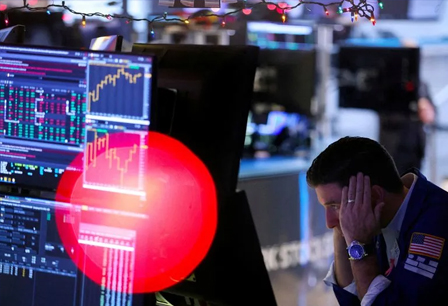Wall Street investors are reaching for their neck braces in preparation for yet another volatile swing in stock markets: A surging US dollar.
The greenback — which is not just the dominant global currency but also “the key variable affecting global economic conditions,” according to the New York Federal Reserve — reached a 20-year high last year after the Fed turned hawkish with its aggressive rate hikes.
Since then, inflation seemed to have softened, pushing the dollar down. But in recent weeks, as a slew of economic data has shown the Fed’s inflation battle is far from over, the currency soared by about 4% from its recent lows, and now sits near a seven-week high.
Investors are stressing about this sudden rebound, since a stronger dollar means American-made products become more expensive for foreign buyers, overseas revenue decreases in value and global trade weakens.
Multinational companies, naturally, aren’t thrilled about any of this. And around 30% of all S&P 500 companies’ revenue is earned in markets outside the US, said Quincy Krosby, chief global strategist for LPL Financial.
What’s happening: The US dollar “finds itself at a significant crossroads yet again,” said Krosby. “While the Fed remains steadfastly data dependent, the dollar’s course as well remains focused on inflation and the Fed’s monetary response.”
“The strong US dollar has been a headwind for international earnings and stock performance (for US investors),” wrote Wells Fargo analysts in a recent note.
February was a rough month for markets: The Dow ended February down 4.19%, the S&P 500 fell 2.6% and the Nasdaq lost just over 1%.
What’s next: Investors are clearly focused on the next Fed policy meeting, which is still three weeks away, for signals about the direction of rates. But until then, investors may gain some insight Tuesday when Fed Chairman Jerome Powell speaks before the Senate Banking Committee.
They’ll also be watching next Friday’s jobs report for any softening in the labor market that could temper the Fed’s hawkish mood.
Don’t forget the debt ceiling: Another significant threat to the dollar is looming in Congress — the ongoing debt ceiling fight. The United States could start to default on its financial obligations over the summer or in the early fall if lawmakers don’t agree to raise the debt limit — its self-imposed borrowing limit — before then, according to a new analysis by the Bipartisan Policy Center.
That could potentially lead to a disastrous downgrade to America’s credit rating and could send the dollar spiraling as investors start to sell off their US assets and move their money to safer currencies.
“It would certainly undermine the role of the dollar as a reserve currency that is used in transactions all over the world. And Americans — many people — would lose their jobs and certainly their borrowing costs would rise,” Treasury Secretary Janet Yellen told CNN in January.












